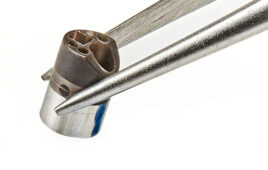
Wearable sensors measure skin temperature in addition to glucose, lactate, sodium and potassium in sweat. Integrated circuits analyze the data and transmit the information wirelessly to a smartphone or other device. (Credit: Der-Hsien Lien and Hiroki Ota,/UC-Berkeley)
A team of researchers has combined two separate technologies to create a health-monitoring device that is noninvasive, doesn’t interfere with strenuous outdoor activities and can continuously track a user’s health at the molecular level.
The two-part system of flexible sensors and a flexible circuit board sticks to the skin and then detects and analyzes a profile of chemicals in sweat.
The device is described in a paper published online Jan. 27 in Nature.
The project, led by senior author Ali Javey, PhD, professor of electrical engineering and computer sciences at the University of California-Berkeley, is a collaboration with researchers at the Stanford University School of Medicine.
“This wearable device provides more information than the currently commercialized wearable sensors. It provides insight about an individual’s physiological state at molecular levels,” said Sam Emaminejad, PhD, a joint postdoctoral scholar at Stanford and at UC-Berkeley, who is the co-lead author with UC-Berkeley postdoctoral scholar Wei Gao, PhD.
Other noninvasive sweat biosensors either monitor only a single molecule at a time or lack signal processing that can adjust for temperature effects or interactions among different molecules. The new device, tested on a team of sweaty volunteers, is a fully-integrated “perspiration analysis system” that binds to the skin and measures certain sweat metabolites and electrolytes, and can calibrate its readings based on skin temperature. In the future, this kind of wearable biosensor could be able to alert athletes and patients to fatigue, dehydration, overheating and other health problems.
Emaminejad said that when he first came to Stanford several years ago, he wanted to earn a doctorate in electrical engineering and to work with renowned scientist Ron Davis, PhD, professor of biochemistry and of genetics and director of the Stanford Genome Technology Center. Over a 50-year career, Davis has been the originator, with others, of a series of disruptive technologies, such as a way to map RNA, a technique for splicing fragments of DNA together, the first DNA microarray for profiling the expression of genes and a method for mapping genes that led to the Human Genome Project. His work has repeatedly changed the face of biomedical research and earned him membership in the National Academy of Sciences.
“For personalized medicine,” said Davis, “we need sophisticated biosensors that can collect data continuously from individuals.”
When a patient goes for an appointment, said Emaminejad, the physician can take a blood sample and measure any of hundreds of molecules. But at best, the physician typically gets only one measurement every few months. There’s no telling what’s happening between patient visits. To monitor health continuously, a new technology was needed. “We wanted to move from the kind of cumbersome equipment used in a clinic to a light, wearable device that could deliver continuous measurements,” he said.
Devices like the Fitbit already monitor people’s activity levels and heart rate, but the researchers needed far more information. They wanted to be able to noninvasively map the molecular physiology of an individual’s body. The answer, they realized, was sweat.
What’s More Personal Than Sweat?
“Sweat is hugely amenable to wearable applications and a rich source of information, so our first step in developing wearable biosensing technologies was to think about how to analyze sweat,” said Davis.
Sweat is loaded with physiological information about what’s happening in the body, with hundreds of different constituents — from simple ions to metabolites and protein molecules.
Until now, sweat studies have collected perspiration off the body in containers and then analyzed it in the lab. Sweat can be used to diagnose certain diseases, to detect drug use and to optimize athletic performance. But the resulting data aren’t real-time or continuous. It’s like watching 10 seconds of a football game and trying to guess how the rest of the game went.
Designing the Device
After earning a PhD in electrical engineering at Stanford, Emaminejad became a postdoctoral scholar jointly at Stanford and UC-Berkeley. The result of the collaboration is the new sensor technology that can detect the chemical constituents of sweat in real time. The research team tested the device on a group of men and women who pedaled indoors on stationary bikes or ran outdoors.
The prototype device consists of two parts: a set of five sensors and a flexible circuit board for signal processing and wireless transmission of data. Sticking to the skin is a flexible plastic bandage with sensors that can measure skin temperature and four constituents of sweat: sodium ions, potassium ions, glucose sugar and lactate.
The soft, flexible sensor bandage feeds data from the skin to the second part of the device, a wireless circuit board of interconnected chips, called a flexible printed circuit board, which comes as a wristband or headband.
The circuit board’s job is to amplify, filter, calibrate and transmit the signal. After processing the information from the sensors, the circuit board beams it to a nearby smartphone or other device for storage and further analysis. The flexible sensor array that binds to the skin is disposable and might last a few days at most, while the less-flexible printed circuit board is reusable.
Complementary Technologies
Neither the sensor nor the circuit board could have done the job by itself. “Each technology has strengths and weaknesses,” said Javey. “If you were just using silicon integrated circuits, you would not have been able to do this work. Silicon integrated circuits are too small and too rigid to come in good contact with the skin. It’s just not realistic to use them for the sensing part.”
On the other hand, a flexible integrated sensor array can be printed onto a large area that conforms to the body. It makes a great sensor but isn’t as good for doing computation, signal processing or transmission, said Javey. Together, the two technologies complement one another and create a lightweight biosensor.
The Nature paper describes how the flexible sensors detect the presence of different molecules and ions based on their electrical signals, said Emaminejad. “The more glucose or lactate in your sweat, the more electrical current is generated at the sensor’s surface. And the more sodium and potassium, the larger the voltage.”
“Both the current and the voltage generated are themselves affected by temperature,” Gao said. When your skin temperature goes up, the generated signal from the glucose sensor appears larger, making it look like you are releasing more glucose in your sweat than you actually are. As a result, it’s important to measure both temperature and molecules at the same time to calibrate the device.
The device could open up new fields of research. “With continuous, real-time monitoring of populations of people,” said Davis, “we’ll be able to mine the collected data for patterns that can guide clinically oriented investigations and deliver personalized medicine.”
The work is an example of Stanford Medicine’s focus on precision health, the goal of which is to anticipate and prevent disease in the healthy and precisely diagnose and treat disease in the ill.
Emaminejad said the device will enable researchers to conduct science experiments that couldn’t be done before. “I think we will learn a lot about sweat itself and what its composition is telling us about our health,” he said.




